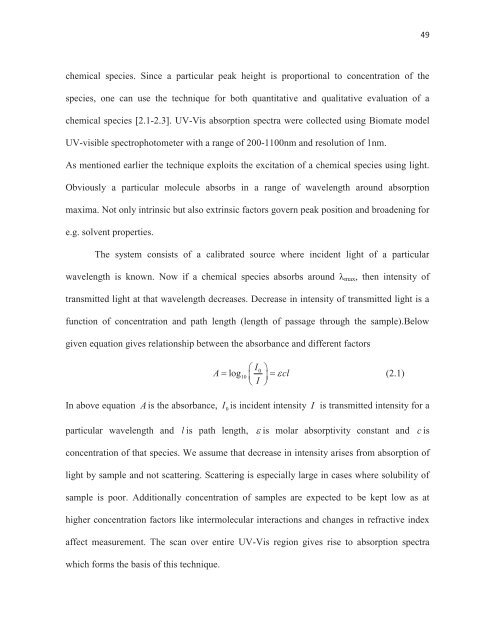CHEM01200604009 Sreejith Kaniyankandy - Homi Bhabha ...
CHEM01200604009 Sreejith Kaniyankandy - Homi Bhabha ...
CHEM01200604009 Sreejith Kaniyankandy - Homi Bhabha ...
You also want an ePaper? Increase the reach of your titles
YUMPU automatically turns print PDFs into web optimized ePapers that Google loves.
49<br />
chemical species. Since a particular peak height is proportional to concentration of the<br />
species, one can use the technique for both quantitative and qualitative evaluation of a<br />
chemical species [2.1-2.3]. UV-Vis absorption spectra were collected using Biomate model<br />
UV-visible spectrophotometer with a range of 200-1100nm and resolution of 1nm.<br />
As mentioned earlier the technique exploits the excitation of a chemical species using light.<br />
Obviously a particular molecule absorbs in a range of wavelength around absorption<br />
maxima. Not only intrinsic but also extrinsic factors govern peak position and broadening for<br />
e.g. solvent properties.<br />
The system consists of a calibrated source where incident light of a particular<br />
wavelength is known. Now if a chemical species absorbs around λ max , then intensity of<br />
transmitted light at that wavelength decreases. Decrease in intensity of transmitted light is a<br />
function of concentration and path length (length of passage through the sample).Below<br />
given equation gives relationship between the absorbance and different factors<br />
I<br />
Alog 10 <br />
I<br />
0<br />
<br />
cl<br />
<br />
(2.1)<br />
In above equation A is the absorbance, I0<br />
is incident intensity I is transmitted intensity for a<br />
particular wavelength and l is path length, is molar absorptivity constant and c is<br />
concentration of that species. We assume that decrease in intensity arises from absorption of<br />
light by sample and not scattering. Scattering is especially large in cases where solubility of<br />
sample is poor. Additionally concentration of samples are expected to be kept low as at<br />
higher concentration factors like intermolecular interactions and changes in refractive index<br />
affect measurement. The scan over entire UV-Vis region gives rise to absorption spectra<br />
which forms the basis of this technique.
















